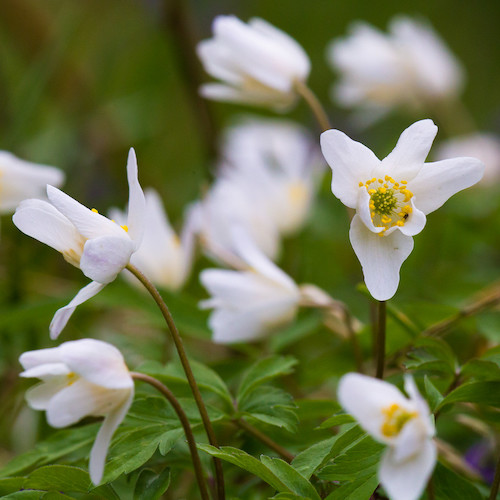
Also known as Windflower, the Wood Anemone is a flower of early spring, found in woodland glades and old hedgerows.
Photo: Steve Townsend
Scientific name: Anemone nemorosa
Other common names: Wind-flower, Grandmother’s Nightcap, Moggie Nightgown, Thimbleweed, Smellfox
What to look for:
- Flowers: a single white flower, sometimes purple-tinged, six to seven large ‘petals’ (see ‘Did you know…’ below), and with long yellow stamens
- Leaves: Whorl of three deep-lobed leaves half way down the flower stalk; other leaves grow from ground level
- Height: Variable – from 5 to 30 cm
- Where: Deciduous woodland, hedgerows, stream banks, moorland and upland meadows
- When: Flowers from March to April/May
- Habit: A perennial that spreads slowly by underground rhizomes, and so can form carpets of flowers in the spring wherever it has been established for a long time
The white flowers of the Wood Anemone briefly take to the stage in the early spring, strewn like stars through woodland glades or below old hedgerows. One of the indicators of ancient woodland, it’s a welcome sight as the weather starts to warm after winter. It even has a poetical name: the genus name Anemone is from the Greek meaning ‘daughter of the wind’ (perhaps in reference to the early spring breezes), while the species name of nemorosa is from the Latin for ‘wooded’ or ‘shady’.

This early flowering is in fact an evolutionary strategy shared with other woodland plants, such as the Primrose, enabling the plants to take advantage of the sunlight before leaves grow on the trees and shade the woodland floor. The energy created is then stored in underground rhizomes for the remainder of the year, ready to produce flowers the following year. The plant spreads from these rhizomes – its seed is generally infertile – but only very slowly, perhaps only by 2 m in a 100 years (Mabey, 1997). If, therefore, you are lucky enough to find a glade full of Wood Anemone, you will know it has been growing there a long time. This slow growth habit also means it hardly ever spreads beyond its established sites, making it particularly dependent on the preservation and management of old woodland and hedgerows.
Did you know…?
…The white or purple-tinged ‘petals’ of the Wood Anemone are actually sepals. The plant has no petals.
…The musky scent of Wood Anemone is the reason behind one of its other common names: Smellfox.
More information and references:
Gilmour, J. and Walters, M., 1954. Wild Flowers: Botanising in Britain (New Naturalist Series). Collins, London.
Mabey, R., 1997. Flora Britannica. Chatto & Windus, London.
Rackham, O., 2006. Woodlands (The New Naturalist Library). HarperCollins, London.
Rose, F. and O’Reilly, C., 2006. The Wild Flower Key, 2nd edition. Frederick Warne, London.
Stace, C., 2010. New Flora of the British Isles, 3rd edition. Cambridge University Press, Cambridge.
Published: April 2014
Author: Amanda Scott
Photos: © Natural England / Allan Drewitt

